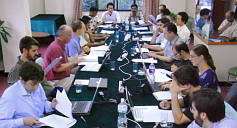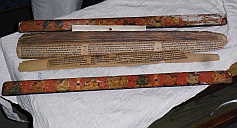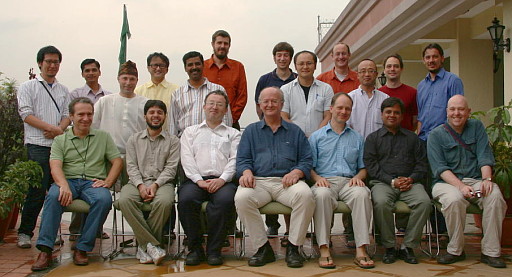First International Workshop on Early Tantra
15th–26th September 2008
Hotel Gangjong, Kathmandu, Nepal
Readings and Presentations
 The First International Workshop on Early Tantra — first of three workshops planned under the Early Tantra project — brought together specialists for the purpose of uncovering interrelationships in the formative period of tantric literature. For two weeks, participants fruitfully read together and worked on draft editions of four important early tantric texts. These works, two Śaiva and two Buddhist, set forth a variety of teachings which exert distinct influence on the later traditions. Discussion focused on linguistic peculiarities and commonalities in the selected corpus, and on related problems of editing and interpretation. The reading sessions, held in the mornings, covered the following titles:
The First International Workshop on Early Tantra — first of three workshops planned under the Early Tantra project — brought together specialists for the purpose of uncovering interrelationships in the formative period of tantric literature. For two weeks, participants fruitfully read together and worked on draft editions of four important early tantric texts. These works, two Śaiva and two Buddhist, set forth a variety of teachings which exert distinct influence on the later traditions. Discussion focused on linguistic peculiarities and commonalities in the selected corpus, and on related problems of editing and interpretation. The reading sessions, held in the mornings, covered the following titles:
- Niśvāsaguhyasūtra: Chapter 3 (entitled sarvasiddhisandoha) and Chapter 8 (the prakriyāyāgapaṭala). This work is being edited by a group at Pondicherry; the readings were led by Alexis Sanderson.
- Brahmayāmala: Chapter 21, on the nine vratas and their associated goddesses, edited by Csaba Kiss; and Chapter 39, on the ‘Razor’s Edge Observance’ (asidhāravrata), edited by Shaman Hatley. The readings were led by Alexis Sanderson.
- Mañjuśriyamūlakalpa: Chapter 13, on homa procedure, and Chapter 51, on the preparation of a painting of Yamāntaka and its use in ritual for aggressive purposes, edited by Martin Delhey. The readings were led by Alexis Sanderson and Martin Delhey (Ch.13) and Harunaga Isaacson (Ch.51).
- Trisamayarājatantraṭīkā: An extract showing the relationship between the trisamaya and the triratna, and the Yogācāra flavour of the anonymous commentator’s exegesis, edited and read by Harunaga Isaacson.
Lectures
In the afternoons, participants gave papers on their research into the early tantric literature, which shed further light on some of the features shared among these tantras. Papers focused on the characteristics of a particular tantric system, or presented up-to-date surveys of some aspect of the field. The opening and closing presentations of the Workshop, given by Alexis Sanderson and Péter Szántó respectively, were designated open lectures, and during these sessions local scholars and visitors filled the meeting room to capacity.
Excursions
 Participants were able to inspect at first hand the manuscripts of several early tantric works, including those being studied in the workshop. The management of the Kaiser Library (Kesar Pustakālaya) and National Archives (Rāṣṭrīyābhilekhāya) kindly allowed this examination of the original manuscripts, which in some cases are the earliest or only surviving witnesses. On another occasion, participants were shown the work of the Nepalese German Manuscript Cataloguing Project underway at the Nepal Research Centre.
Participants were able to inspect at first hand the manuscripts of several early tantric works, including those being studied in the workshop. The management of the Kaiser Library (Kesar Pustakālaya) and National Archives (Rāṣṭrīyābhilekhāya) kindly allowed this examination of the original manuscripts, which in some cases are the earliest or only surviving witnesses. On another occasion, participants were shown the work of the Nepalese German Manuscript Cataloguing Project underway at the Nepal Research Centre.
 Over the weekend, participants were offered two excursions to visit tantric sites in the Kathmandu Valley. The half-day walking excursion (20th September) took in sites from the north to the central quarter of the old town of Kathmandu. The full-day bus excursion (21st September) went further afield, beginning at the yoginī shrine and charnel ground at Vijayeśvarī, going on to Cilaṃco and Bāgh Bhairava at Kīrtipur, and finishing up at various historic sites located at or nearby Pharping, in the southwestern corner of the Valley. At these sites participants had the opportunity to observe practices, shrines and inscriptions which are not often accessible to visitors, and to witness the only living tradition in which Śaiva, Vaiṣṇava and Buddhist tantrism continue to interact.
Over the weekend, participants were offered two excursions to visit tantric sites in the Kathmandu Valley. The half-day walking excursion (20th September) took in sites from the north to the central quarter of the old town of Kathmandu. The full-day bus excursion (21st September) went further afield, beginning at the yoginī shrine and charnel ground at Vijayeśvarī, going on to Cilaṃco and Bāgh Bhairava at Kīrtipur, and finishing up at various historic sites located at or nearby Pharping, in the southwestern corner of the Valley. At these sites participants had the opportunity to observe practices, shrines and inscriptions which are not often accessible to visitors, and to witness the only living tradition in which Śaiva, Vaiṣṇava and Buddhist tantrism continue to interact.
Schedule
Week 1
15 am Niśvāsaguhyasūtra 3
15 pm Alexis Sanderson: ‘The Śaiva Age’, Part 1
16 am Niśvāsaguhyasūtra 3
16 pm Alexis Sanderson: ‘The Śaiva Age’, Part 2
17 am Brahmayāmala 21
17 pm Visit to Kaiser Library
18 am Brahmayāmala 21
Brahmayāmala 39
18 pm Visit to the Nepal Research Centre
Csaba Kiss, ‘‘Introduction to the Brahmayāmala‘
Shaman Hatley, ‘On the Relationship between the Brahmayāmala and the Dīkṣottara‘
19 am Niśvāsaguhyasūtra 8
19 pm Dominic Goodall, ‘Vidyādīkṣā and Muktidīkṣā: initiations in the Niśvāsa-corpus’
20 am Walking excursion, Kathmandu
21 am/pm Bus excursion, Vijayeśvarī / Kīrtipur / Pharping
Week 2
22 am Niśvāsaguhyasūtra 8
22 pm Diwakar Acharya, ‘The Jayottaratantra: the Urtext of the Jayākhyasaṃhitā‘
23 am Niśvāsaguhyasūtra 8
Mañjuśriyamūlakalpa 13
23 pm Visit to National Archives, Kathmandu
Michael Slouber, ‘The Earliest Sources for the Bhūta and Gāruḍa Tantras’
Nirakan Kafle, ‘A Summary of Chapter 14 of the Niśvāsaguhyasūtra‘
24 am Mañjuśriyamūlakalpa 13
24 pm Martin Delhey, ‘The Mañjuśriyamūlakalpa and its Early Nepalese Witness’
25 am Mañjuśriyamūlakalpa 51
25 pm Harunaga Isaacson, ‘Remarks on Trisamayarājatantra material surviving in Sanskrit’
26 am Trisamayarājatantraṭīkā
26 pm Péter-Dániel Szántó, ‘Notes on the Catuṣpīṭha, an early Buddhist yoginītantra’
Reception: Nepal Research Centre, Kathmandu
Participants
Shaman Hatley (Concordia U.); Dominic Goodall, Nirajan Kafle, Csaba Kiss, SAS Sarma, Satyanarayana (EFEO, Pondicherry); Anil Kumar Acharya (IFP, Pondicherry); Martin Delhey, Harunaga Isaacson, Kenichi Kuranishi, Iain Sinclair (Hamburg U.); Wiesiek Mical (Kathmandu U.); Kazuo Kano (Koyasan U.); Diwakar Acharya (Kyoto U.); Kei Kataoka (Kyushu U.); Andrea Acri (Leiden); Francesco Sferra (Naples); Alexis Sanderson, Péter-Daniél Szántó (Oxford); Simone Baretta (University of Pennsylvania); Taiken Kyuma, Ryugen Tanemura (Tokyo U.); Alexander von Rospatt, Michael Slouber, and Christopher Wallis (UC Berkeley).
Attendees and Visitors
Franciscus Verellen (EFEO); Ellen Coon, Rajini Maharjan, Hubert Decleer (Chhauni); Kengo Harimoto (Hamburg U.); Claudia Keller (Würzburg U.); Michael Allen (Sydney); Min Bahadur Shakya, Milan Shakya and others (NIEM, Lalitpur); Harihar Joshi; Manik Vajracharya (Aichi Gakuin); Arthur McKeown (Harvard / LIRI); Kāśīnāth Nyaupāne (Kathmandu U.); Puṇya Prasād Parājulī (National Archives, Kathmandu); Albrecht Hanisch, Kāśīnāth Tamoṭ and others (Nepal Research Centre).
Acknowledgements
Harunaga Isaacson (Chief organizer); Albrecht Hanisch, Navaraj Gurung (Coordinators, Nepal Research Centre); Kāśīnāth Tamoṭ and Iain Sinclair (excursions).
The organizers gratefully acknowledge funding of this workshop by the DFG and of the Early Tantra project by the ANR and DFG. We additionally thank Mr. Bhim Prasad Nepal (National Archives, Kathmandu) and Mr. Bhola Kumar Shrestha (Kaiser Library) for their assistance and hospitality.
Further Information
Editions of all four texts studied in the Workshop are currently under preparation as part of the Early Tantra project. Selected papers from the Workshop may be published in connection with this project, as part of a separate volume.
The second Workshop is planned to take place at the EFEO Centre in Pondicherry, India, in 2009.

